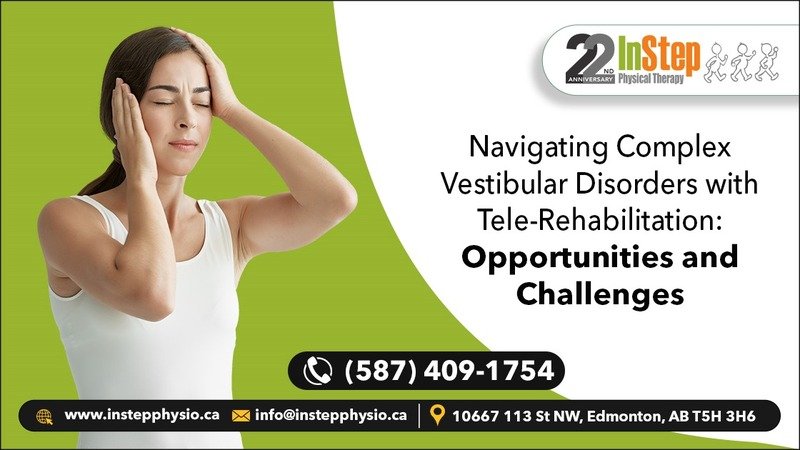Living with a vestibular disorder can significantly impact one’s quality of life, affecting balance, spatial orientation, and even the simplest daily activities. Vestibular physiotherapy Edmonton offers a specialized approach to managing these challenges. It focuses on the intricate vestibular system—comprising the inner ear and brain—that regulates balance and spatial awareness.
Opportunities of Telerehabilitation in Navigating Complex Vestibular Disorders
1. Increased Reach and Equity
- Access to Specialized Care: Telerehabilitation enables patients with complex vestibular disorders, such as Meniere’s Disease, Vestibular Migraine, BPPV, Vestibular Neuritis and Labyrinthitis, and PD, in remote or underserved locations to access expert care without the need for travel. This is crucial for conditions that require specialized management and continuous monitoring.
- Health Equity: Provides equitable access to high-quality care for diverse populations, ensuring that individuals from various socio-economic backgrounds can receive appropriate treatment for their vestibular disorders.
2. Cost-Effectiveness
- Reduced Costs: Decreases travel expenses, time off work, and other associated costs for patients managing chronic conditions like vestibular disorders. This is particularly beneficial for patients who need regular follow-ups and continuous care.
- Efficiency: Streamlines healthcare delivery, reducing the burden on healthcare systems by minimizing in-person visits and enabling efficient management of patient care remotely.
3. Technological Advancements
- Innovative Tools: Vestibular physiotherapy in Edmonton utilizes wearable devices, mobile apps, and virtual reality to enhance therapy and patient engagement. For example, wearable devices can monitor balance and vertigo episodes, while virtual reality can be used for vestibular rehabilitation exercises.
- Data Analytics: Data from digital tools are used to provide insights into treatment efficacy and patient progress, allowing for personalized and adaptive treatment plans for complex vestibular disorders.
4. Improved Patient Engagement
- Interactive Platforms: Engages patients through user-friendly digital interfaces, making it easier for them to access information, track their symptoms, and follow their treatment plans.
- Motivation and Compliance: Increases patient motivation and compliance with treatment plans through regular feedback and support, essential for managing chronic vestibular conditions effectively.
Challenges of Telerehabilitation in Navigating Complex Vestibular Disorders
1. Technological Barriers
- Access to Technology: Some patients may lack access to necessary devices or reliable internet connections, which can limit their ability to participate in telerehabilitation programs.
- Digital Literacy: Patients and providers may need training to effectively use telehealth platforms, which can be a barrier to effective implementation and utilization.
2. Clinical Limitations
- Hands-On Care: Certain assessments and interventions, such as specific maneuvers for BPPV or physical examinations for vestibular neuritis, require physical presence and hands-on manipulation that cannot be replicated virtually.
- Accurate Diagnosis: Some conditions might require in-person tests and evaluations, such as audiometric tests for Meniere’s Disease or MRI scans for complex vestibular conditions, which are challenging to perform remotely.
3. Privacy and Security Concerns
- Data Protection: Maintaining the confidentiality and security of patient data is critical, and telehealth platforms must comply with relevant regulations to protect sensitive health information.
- Confidentiality: Maintaining confidentiality in virtual settings can be challenging, especially in shared or public spaces, which can affect patient comfort and openness during consultations.
4. Regulatory and Reimbursement Issues
- Regulatory Compliance: Navigating the regulatory landscape for telehealth services can be complex, with varying requirements across regions, which can affect the implementation and operation of telerehabilitation programs.
- Insurance Coverage: Securing adequate reimbursement from insurance providers for telehealth services can be challenging, potentially limiting the accessibility and affordability of telerehabilitation for patients with vestibular disorders.
Common Vestibular Techniques Used in Telerehabilitation:
Telerehabilitation is transforming the management of complex vestibular disorders, offering patients effective and accessible treatment options from the comfort of their homes. Through virtual platforms, vestibular physiotherapy in Edmonton delivers tailored techniques to address conditions such as Benign Paroxysmal Positional Vertigo (BPPV), vestibular neuritis, and Meniere’s disease. These disorders, often resulting in debilitating symptoms like dizziness, vertigo, and balance issues, can be managed effectively through remote guidance and personalized rehabilitation programs.
Vestibular neuritis is managed through gaze stabilization exercises, helping patients maintain visual focus during head movements, reducing dizziness, and improving balance. For Meniere’s disease, balance retraining exercises enhance stability and prevent falls. These methods address immediate symptoms and focus on long-term improvements in a patient’s quality of life by providing continuous support and guidance remotely.
By leveraging telerehabilitation, patients can perform these exercises under professional supervision, ensuring correct execution and progress monitoring, which is vital for the effective management of these complex vestibular disorders.
Towards a Balanced Future:
Whether conducted in-person or through telerehabilitation, In Step Physical Therapy in Edmonton plays a crucial role in restoring balance, improving spatial orientation, and improving the overall life quality of individuals with vestibular disorders. While traditional in-person therapy offers hands-on techniques and direct supervision, telerehabilitation provides accessible, convenient, and personalized care options, overcoming geographical barriers and accommodating diverse patient needs.
Both approaches contribute to the comprehensive management of vestibular disorders, empowering patients to regain confidence in their daily activities through targeted vestibular rehabilitation therapy strategies. As telehealth technology continues to evolve, integrating these advancements with clinical expertise promises to further optimize outcomes and expand access to effective vestibular rehabilitation worldwide.
